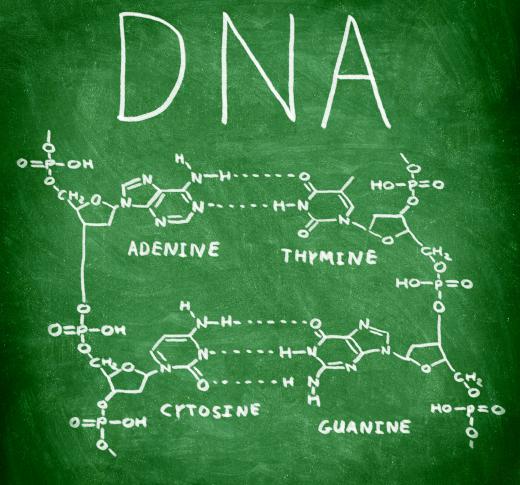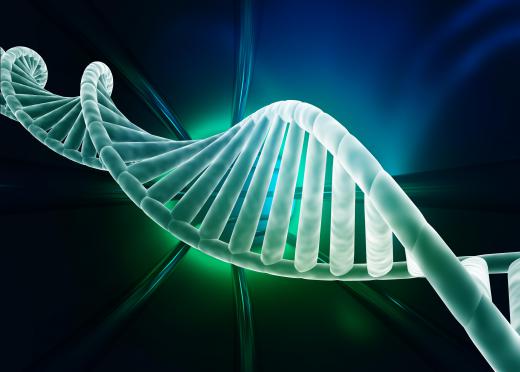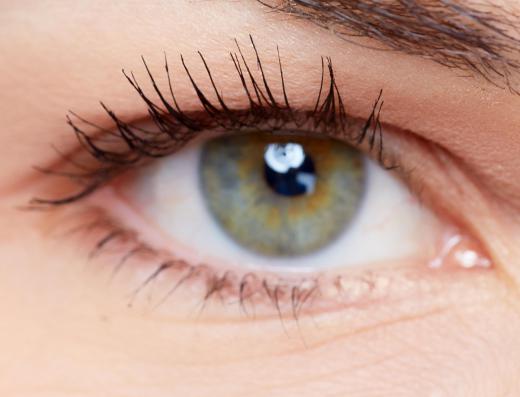What is DNA?
 Mary McMahon
Mary McMahon
Deoxyribonucleic acid (DNA) is a nucleic acid present in the cells of all living organisms. It is often referred to as the “building blocks of life,” since it encodes the genetic material that determines what an organism will develop into. In addition to maintaining the genetic blueprints for its parent organism, DNA also performs a number of other functions which are critical to life.
This nucleic acid was first identified in 1889, when researcher Friedrich Miescher found a substance he called “nuclein” in human cells. In the early 20th century, several researchers, including Phoebus Levene and William Astbury, performed additional research on nuclein, beginning to understand its components, structure, and role in life. A seminal article published in Nature in 1953 by James Watson and Franklin Crick is often cited as the breakthrough moment, as it correctly posited the distinct structure of this acid, with significant help from scientist Rosalind Franklin.

DNA is composed of chains of nucleotides built on a sugar and phosphate backbone and wrapped around each other in the form of a double helix. The backbone supports four bases: guanine, cytosine, adenine, and thymine. Guanine and cytosine are complementary, always appearing opposite each other on the helix, as are adenine and thymine. This is critical in the reproduction of the genetic material, as it allows a strand to divide and copy itself, since it only needs half of the material in the helix to duplicate successfully.

This nucleic acid is capable of self replication, and it also contains the code necessary for synthesizing RNA, another critical nucleic acid. It contains sets of base pairs that come together to create the genetic code, determining things like eye color and body structure. Each cell in the body contains DNA that is more or less identical, with more being produced all the time as cells replicate themselves. The vast majority in most organisms is non-coding, meaning that it does not appear to have any known function.

When DNA becomes altered by a substance known as a mutagen, it can cause health problems. Some mutagens have an impact on DNA in the eggs and sperm, or on developing organisms, causing them to develop birth defects. Others can change living organisms, contributing to the development of a variety of health problems. Mutagens often introduce errors at the copying stage, which means that these errors will be replicated numerous times as the damaged material perpetuates itself.
AS FEATURED ON:
AS FEATURED ON:















Discussion Comments
Can DNA be transmitted via kissing and affect a newborn if the kissed is pregnant?
They came into the game knowing that DNA was probably composed of two strands and what elements made up those strands and that the gene markers made up the DNA, they weren't the DNA itself.
In particular Rosalind Franklin did a lot of work on the DNA structure and discovered that it was made up of two strands before the other two basically used all her work to prove their own theory. She hardly ever gets credit, since they won the Nobel prize, but I think that's a shame because our understanding of DNA sequencing owes a lot more to her than to them.
They were right on the verge of a breakthrough when one of them had a dream about a pair of snakes, coiled against each other, one with a head pointed down, the other with the head pointed up.
The next day, he realized that if DNA models were arranged like that, it would fit everything and history was made.
easier to understand! Thanks!
thank you! its easy to understand and to cite.
Thanks lot. It will help me for my research on dna.
thanks. this article is understandable and helpful at the same time. keep up the good work people.
Wow. Thank you! I learned a lot. Also you saved me because i have to do a project on dna and it's due tomorrow and i didn't even get started yet. yikes!
Thanks. this makes it easier to understand.
this was really helpful. you saved my butt.
thanks. this makes it easier to understand.
really easy to understand. thanks!
this seems like a nice article.
Short, simple, to the point! Thanks, this helped me out a lot on my Biology final.
Post your comments